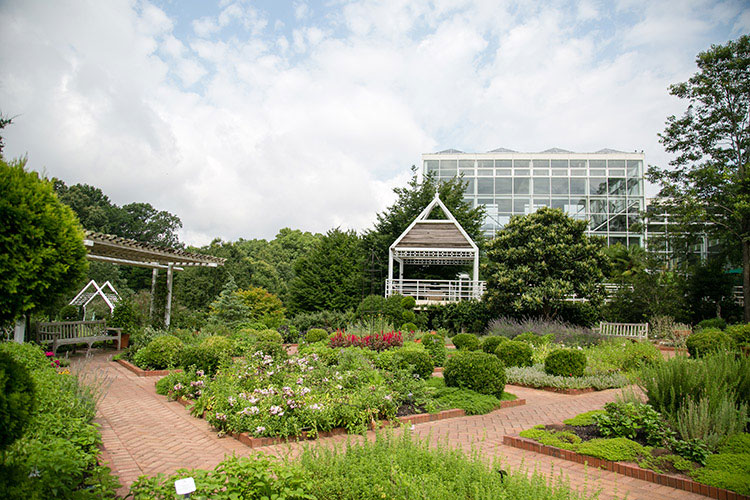The Main Conservatory
of the Visitor Center

Carol Rudow
Curator
Main Conservatory, Herb & Physic Garden
Plants from the world’s tropical rainforests enrich our lives every day. For some, a day without a drink of coffee, cola or tea would spell disaster, yet seldom do we give pause to the origin of these flavors. Species found exclusively in equatorial climates benefit us in each of our necessities: our diets, our clothing and our homes.
Fruiting plants such as pineapple, avocado, mango, papaya, breadfruit, macadamia, star fruit and banana provide nutrition for households around the world. Some of these are even bursting with anti-oxidants. For centuries spices like ginger, allspice, turmeric and pepper have been valued for their ability to preserve and flavor foods. The use of cinnamon can even be traced back to ancient Egypt where it functioned as an embalming agent. Now its uses have expanded to treating indigestion, discouraging urinary tract infections, preventing ulcers and promoting oral hygiene.
In the home fibers, soaps and oils harvested from tropical rainforests become raw materials for dozens of everyday products. Bamboo, palm and mahogany timbers also create building supplies and components for furnishings. Rainforest ecosystems also contribute to our health in a broader sense. On a global scale, these forests act as buffers, moderating weather patterns and temperature. They are also crucial to the maintenance of our limited supplies of drinkable fresh water.
Hundreds of prescription medications are derived from species native to these habitats—compounds that treat malaria, heart disease, bronchitis, hypertension, diabetes, dysentery, etc. The true ecological and economic importance of tropical forests is not yet fully understood, however one thing remains clear: Considering all of the benefits that we receive from tropical forests, conserving these areas and promoting their sustainable harvest is truly imperative.
The Tropical Collection of the Visitor Center & Conservatory seeks to foster an appreciation of tropical plants by showcasing examples of these valuable species. We hope that this will bring awareness to a habitat that sadly continues to diminish throughout the world.
The Herb & Physic Collections
Part of the International Garden
During the Middle Ages, monastic gardens allowed religious orders to operate almost self-sufficiently within their monastery walls. These spaces provided nearly all of the food, medicine, dyes, fibers and fragrances needed by servants, guests and monks. They also provided a laboratory in which the monks could advance their knowledge of horticulture.
The center parterre (arrangement of beds) of the Herb Collection features specimens typical of these cloistered gardens, paying tribute to the precursors of modern day botanical gardens. The other areas of the Herb Collection display herbs both culturally and economically significant to ancient peoples around the world—species native to the Americas, Europe, Asia and Africa. Whether the benefits of these plants were truth or legend, today such societies can be described by how they used herbs.
In ancient Greece students donned laurels of rosemary because they believed it enhanced their memory. Although many herbs possess multiple uses, those with special medicinal value are located in the adjoining Physic Collection. Its configuration surrounds a central knot garden, which is reminiscent of late European Renaissance designs. Beginning in the 16th and 17th centuries, European medical schools established physic gardens in order to acquire, study and disseminate botanical knowledge. These areas became predecessors to modern botanical gardens.
The Physic Collection not only contains herbs prized by European medicine, but also those employed in Indian Ayurvedic medicine, traditional Chinese medicine and ancient Egyptian medicine (which later influenced the Greeks and Romans). The collection also features New World specimens that gained popularity in the 18th Century. During this time Dr. Lindsay Durham practiced local medicine in the area of Scull Shoals.
He prescribed many derivatives of native species, like his decoction (liquor produced by boiling plants) of Hamamelis virginiana (Witch Hazel), which was administered during childbirth. Dr. Durham created an extensive pharmacopoeia from his humble 13-acre garden. The benefits of his patents, and the herbs that comprise them, continue to gain appreciation. The Physic Collection offers more than just a tour of the world’s medicinal marvels; it offers a tour of the knowledge that promoted humanity’s success.


